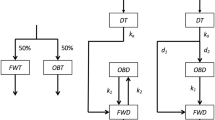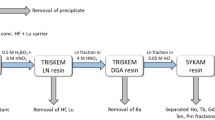Abstract
ZIRCONIUM-95, one of the γ-ray emitting isotopes in fall-out, has a physical half-life of 65 days. It decays to niobium-95 which emits γ-rays and has a physical half-life of 35 days. Therefore, both these isotopes contribute to the total radiation hazard of fall-out. During the first year, these two isotopes share no less than 20 per cent of the total activity of fission products aged from a few days to one year1. A knowledge of the metabolism of the parent isotope (zirconium-95) in relation to that of the daughter (niobium-95) is essential in order to estimate the total internal radiation hazard due to 95Zr–95Nb because the parent and the daughter decay at different rates. Further, the photopeak energies of zirconium-95 (0.72 MeV) and niobium-95 (0.764 MeV) are so close to one another that it is not possible to resolve and identify the individual photopeaks of the parent and daughter isotopes by γ-scintillation spectrometry1. Therefore, we have determined the physical decay patterns of 95Zr–95Nb accumulated by rat tissues to determine whether some tissues show preference for zirconium-95, while others concentrate niobium-95 in four days after intraperitoneal administration of 95Zr–95Nb in transient equilibrium (Fig. 1).
This is a preview of subscription content, access via your institution
Access options
Subscribe to this journal
Receive 51 print issues and online access
$199.00 per year
only $3.90 per issue
Buy this article
- Purchase on Springer Link
- Instant access to full article PDF
Prices may be subject to local taxes which are calculated during checkout
Similar content being viewed by others
References
Radiological Health Handbook, compiled and edited by Div. Radiological Health, U. S. Dept. Health, Educ. and Welfare, 96 (1960).
Rama Sastry, B. V., Weiland, R. L., and Ball, Con O. T., Fed. Proc., 23, 540 (1963).
Rama Sastry, B. V., Weiland, R. L., and Bass, A. D., in Proc. Sec. Symp. Radioactivity in Man, Chicago, 1962, edit. by Meneely, G. R. (Chas. C.Thomas, Springfield, Ill.) (in the press).
Richmond, C. R., Furchner, J. E. Trafton, G. A., Nuclear Sci. Abstracts, 14, 3253 (1960).
Author information
Authors and Affiliations
Rights and permissions
About this article
Cite this article
RAMA SASTRY, B., OWENS, L. & BALL, C. Differences in the Distribution of Zirconium-95 and Niobium-95 in the Rat. Nature 201, 410–411 (1964). https://doi.org/10.1038/201410a0
Issue Date:
DOI: https://doi.org/10.1038/201410a0
This article is cited by
-
Production, applications and status of zirconium-89 immunoPET agents
Journal of Radioanalytical and Nuclear Chemistry (2017)
Comments
By submitting a comment you agree to abide by our Terms and Community Guidelines. If you find something abusive or that does not comply with our terms or guidelines please flag it as inappropriate.



